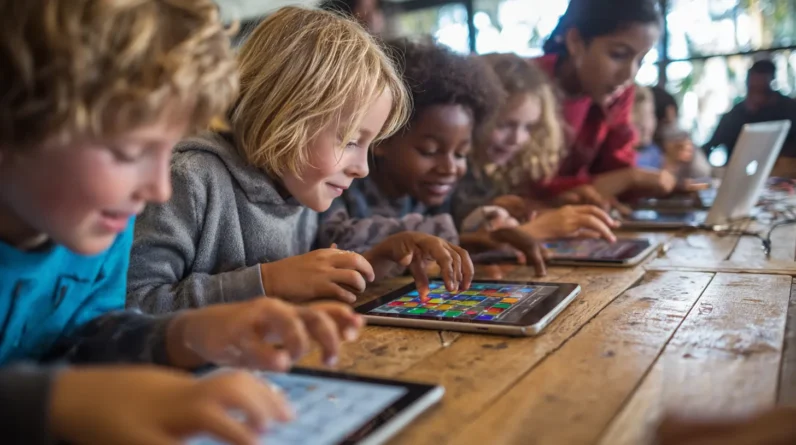
We can transform our children into confident digital citizens by focusing on age-appropriate integration and critical thinking skills rather than avoiding technology altogether. Start with supervised, short sessions for younger kids and gradually increase independence while teaching source evaluation, privacy protection, and cybersecurity basics. Establish consistent routines with screen-free zones, teach strong password creation, and help them recognize bias in digital content. When we approach technology strategically, our children develop essential skills that’ll serve them throughout their digital lives.
Understanding Digital Literacy in the Modern Age
While technology continues to reshape every aspect of our lives, digital literacy has evolved far beyond basic computer skills to become a fundamental requirement for participating in modern society. We’re witnessing unprecedented digital divides that separate those who can navigate complex online environments from those who can’t. Today’s digital literacy encompasses critical thinking about information sources, understanding privacy implications, and mastering online etiquette across diverse platforms.
We must recognize that digital literacy now includes cybersecurity awareness, data interpretation skills, and the ability to collaborate in virtual environments. It’s about creating content responsibly, understanding algorithmic influence, and maintaining digital wellness. When we approach digital literacy exhaustively, we’re preparing learners to thrive rather than merely survive in our interconnected world.
Age-Appropriate Technology Integration Strategies
As we move from understanding digital literacy’s scope to practical implementation, we must tailor our technology integration strategies to match learners’ developmental stages and cognitive abilities. For preschoolers, we’ll focus on short, supervised sessions using educational apps that develop fine motor skills and basic concepts. Elementary students need structured exploration with clear boundaries—this is where effective Device Management becomes vital. We’ll establish usage schedules and designated learning zones.
Middle schoolers require balanced independence with oversight. Implementing robust Parental Controls allows us to gradually expand their digital freedom while maintaining safety guardrails. High schoolers benefit from collaborative goal-setting around technology use, preparing them for autonomous digital citizenship.
Each stage demands different scaffolding approaches, ensuring technology enhances rather than overwhelms learning experiences.
Building Critical Thinking Skills for Online Navigation
Once students can navigate devices appropriately for their age, they need robust critical thinking frameworks to evaluate the overwhelming amount of information they’ll encounter online. We must teach them to question sources, verify claims through multiple channels, and recognize bias in digital content.
Start with concrete evaluation criteria: Who created this content? What’s their expertise? When was it published? Does it align with established facts? We’ll build these skills through guided practice sessions where students analyze websites, social media posts, and news articles together.
Social norms and online etiquette become critical thinking applications. Students learn to assess appropriate sharing, recognize manipulation tactics, and understand digital footprints. We’re not just teaching them to consume information—we’re developing discerning digital citizens who think before they click, share, or believe.
Establishing Healthy Screen Time Boundaries
Building strong critical thinking skills prepares students to make thoughtful decisions about their digital consumption, including how much time they spend on screens. We can establish effective boundaries through structured approaches that balance educational benefits with physical and mental well-being.
Research shows that consistent routines work better than rigid restrictions. We’ll implement device management strategies like scheduled breaks, designated screen-free zones, and clear usage guidelines. Parental guidance plays a vital role in modeling healthy behaviors and explaining the reasoning behind boundaries.
Effective boundary-setting involves collaborative planning where students participate in creating their own limits. This builds ownership and reduces resistance. We’ll use timers, apps that track usage, and regular family discussions to maintain awareness and adjust boundaries as needed for ideal digital wellness.
Teaching Cybersecurity and Privacy Protection
While establishing healthy screen time boundaries creates the foundation for responsible digital behavior, we must equip students with essential cybersecurity knowledge to protect themselves online. Teaching digital citizenship starts with practical privacy protection skills that students can immediately apply.
| Privacy Principle | Student Action | Protection Level |
|---|---|---|
| Strong Passwords | Use unique 12+ character combinations | High |
| Social Media Settings | Configure privacy controls regularly | Medium |
| Personal Information | Never share location or contact details | High |
| Suspicious Links | Verify sources before clicking | Medium |
We’ll integrate online etiquette lessons with security training, showing students how respectful communication prevents digital conflicts. Through hands-on exercises, students practice identifying phishing attempts, creating secure passwords, and recognizing legitimate websites. This approach builds confident, security-conscious digital citizens.
Fostering Creative Expression Through Digital Tools
Digital tools transform students from passive consumers into active creators, empowering them to express ideas through multimedia storytelling, interactive presentations, and collaborative projects. We can leverage platforms like Adobe Creative Suite, Canva, and coding environments to develop students’ creative confidence while building technical skills.
Digital storytelling combines narrative techniques with technology, enabling students to create documentaries, podcasts, and interactive media that demonstrate deep learning. These projects develop critical thinking, communication skills, and technical proficiency simultaneously.
We should encourage tech entrepreneurship mindsets by having students design apps, websites, or digital solutions for real problems. This approach transforms abstract concepts into tangible outcomes while fostering innovation and problem-solving abilities.
Conclusion
Why wouldn’t we want to equip our children with the digital skills they’ll need to thrive? We’ve explored evidence-based strategies that transform screen time from a source of worry into an opportunity for growth. By implementing age-appropriate technology integration, teaching critical thinking, and establishing healthy boundaries, we’re not just protecting our kids—we’re empowering them. Let’s embrace digital literacy as an essential life skill and guide our children toward becoming confident, capable digital citizens.







